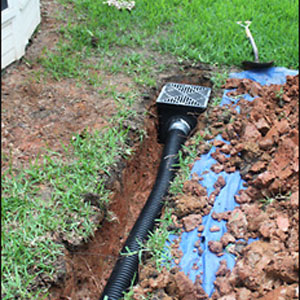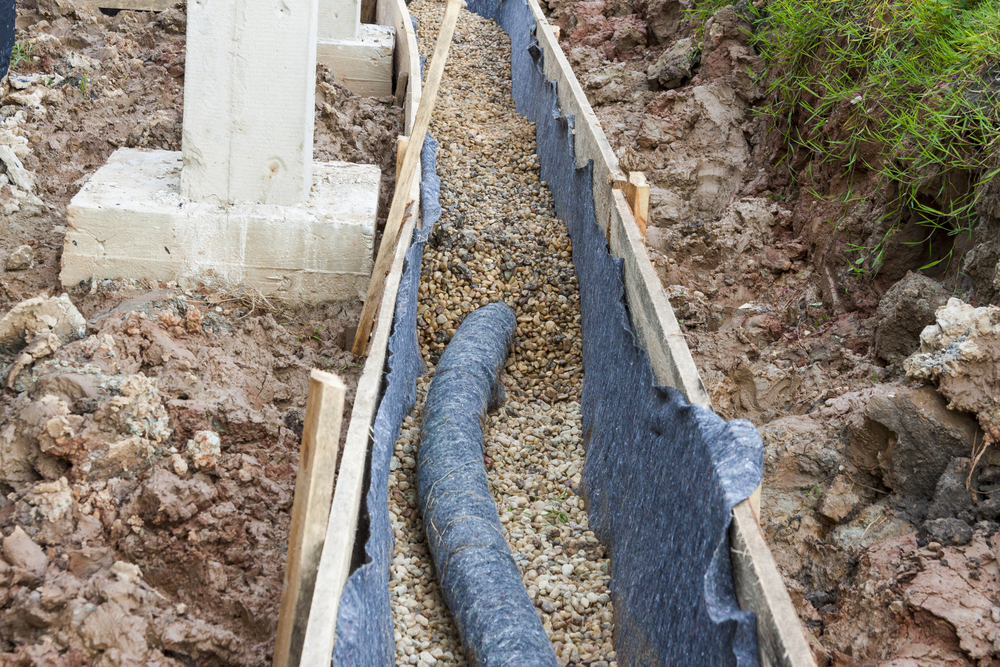Clues You're Dealing With Drainage Issues: Consider Ft Worth French Drain Installation
Clues You're Dealing With Drainage Issues: Consider Ft Worth French Drain Installation
Blog Article
Comprehensive Solutions for Efficient French Drain Installation
When it pertains to handling water drain on your building, understanding the duty of a French drainpipe is crucial. You could think it's just excavating a trench and laying some pipe, yet there's a lot more to it. Appropriate assessment and installment can make all the distinction in protecting against water damages. Interested about what actions you should require to guarantee a successful installment? Allow's check out the essential components and procedures involved.
Understanding the Purpose of French Drainpipes
When it involves handling excess water around your home, recognizing the function of French drains is fundamentally crucial. These water drainage systems efficiently redirect water away from your structure, decreasing the risk of flooding and wetness damage. Basically, French drains pipes contain a trench loaded with gravel or rock, housing a perforated pipe that gathers and networks water.
Analyzing Your Property's Drainage Needs
To evaluate your residential property's drainage requirements, begin by recognizing locations where water tends to collect. Next off, examine the high quality of your soil water drainage, as it plays a vital role in handling water circulation. By understanding these factors, you can make enlightened choices regarding setting up a French drain.
Identifying Water Build-up Areas
Determining water accumulation areas on your residential or commercial property is crucial for effective drainage options. Begin by walking your lawn after hefty rains or snowmelt. Look for pools, soggy areas, or locations where the lawn shows up greener and lusher than the surrounding areas-- these signs show consistent water build-up. Pay attention to low-lying areas, as they commonly gather water. Observe just how runoff acts throughout tornados; does water flow towards your structure or other critical locations? Notice any type of locations where downspouts straight water, as improper drain can aggravate issues. By pinpointing these buildup sites, you can much better figure out where to install French drains pipes, ensuring they work efficiently and shield your building from water damages.
Examining Soil Drainage Top Quality
After pinpointing locations where water often tends to collect, the next step includes assessing the soil drainage quality on your residential or commercial property. To do this, you can do a straightforward water drainage examination. Dig an opening concerning 12 inches deep and load it with water. Observe exactly how swiftly the water drains pipes. Your soil has great water drainage if it disappears within a few hours. However, if it takes even more than a day, you might have clay-heavy soil that keeps water. In addition, think about the soil appearance; sandy soils normally drain well, while silty or clay dirts may trigger problems. Understanding your dirt drainage top quality helps you determine the best solutions for effective French drain installment, guaranteeing your home continues to be well-managed and completely dry.
Key Components of a French Drain System
To develop an effective French drainpipe system, you'll need to focus on a few crucial elements. Selecting the ideal drainage pipeline, utilizing gravel and filter textile, and making certain appropriate slope installation are essential actions. Each element plays an essential role in routing water far from your building successfully.
Drain Pipe Option
When choosing water drainage pipes for your French drainpipe system, it's important to examine the material and diameter that finest matches your specific requirements. Eventually, selecting the ideal water drainage pipeline will certainly enhance your French drainpipe's overall performance, maintaining your property cost-free from undesirable water accumulation.
Crushed Rock and Filter Textile
Gravel and filter fabric are important elements of a well-functioning French drain system. The gravel acts as a drainage medium, allowing water to flow freely while stopping dirt from clogging the system. You'll intend to choose tidy, crushed rock or gravel, as it provides ideal water drainage and supports the pipeline properly.
By wrapping it around the drain pipeline, you develop a barrier that allows water pass via while blocking dirt and particles. With each other, these materials ensure your French drainpipe operates effectively, protecting against water accumulation and protecting your property from prospective damages.
Correct Slope Setup
Achieving the appropriate slope in your French drainpipe is vital for reliable water administration. An incline of at least 1%-- that's a decrease of one inch for every 10 feet-- ensures water moves efficiently towards the drainpipe outlet. To start, note your designated incline along the trench using risks and a string line. As you dig, consistently inspect the deepness to maintain the right slope. It's essential to stay clear of low places where water can pool, so keep your trench consistent. Backfill with crushed rock to protect against and support the drainpipe dirt from clogging the system once you have actually attained the ideal incline. Appropriate slope installation not only boosts water drainage yet likewise expands the life-span of your French drain.
The Setup Process: Step-by-Step
To assure effective water drain around your residential or commercial property, understanding the setup process of a French drainpipe is necessary. You'll need to select the right location, preferably where water builds up. Next off, mark the location and dig a trench regarding 18-24 inches deep and 12 inches wide, guaranteeing it has a consistent incline away from your structure.
Once you have actually prepared the trench, put down a landscape fabric to avoid soil from obstructing the drain. Include a layer of gravel why not try here at the base, concerning 3-4 inches deep. Location the perforated pipeline on top of the crushed rock, making certain the openings encounter down. Cover the pipe with even more gravel, leaving regarding 2-3 inches of room from the top.
Finally, fold the landscape textile over the crushed rock, then fill the trench with dirt - Ft Worth French Drain Installation. Condense the dirt gently, and you're done! Enjoy satisfaction recognizing your building is protected from water damages
Maintaining Your French Drain for Durability
After you've installed your French drain, preserving it is crucial to its long life and effectiveness. Regular evaluations are crucial; look for any debris or debris build-up that can obstruct water circulation. Clear any kind of leaves, dirt, or other materials that may collect at the surface area or around the drainpipe's openings.
It's additionally a good idea to monitor the drainage efficiency during hefty rainfalls. If water swimming pools near the drainpipe, it can suggest a clog that requires prompt focus. Additionally, make sure the surrounding landscaping does not hinder the drain's feature-- origins can attack and obstruct the system.
Maintain an eye on the overall landscape rating to ensure it directs water away from your structure. By taking these steps, you'll guarantee your French drain proceeds to do successfully for years to come.
Common Mistakes to Stay Clear Of During Installation
Even though installing a French drain can seem simple, several homeowners make vital errors that can endanger its effectiveness. One typical mistake is not excavating the trench deep sufficient. If the drainpipe isn't placed below the frost line, it may ice up, providing it pointless during wintertime.
An additional mistake is falling short to keep a correct slope. Your drainpipe should slope a minimum of 1% to guarantee water moves towards the electrical outlet. Neglecting to utilize the right materials can additionally lead to problems; constantly select perforated pipe and crushed rock for peak drainage.
Furthermore, neglecting the value of proper electrical outlet placement can trigger water to support. See to it the outlet routes water far from your foundation. Finally, don't forget to check neighborhood guidelines and licenses, as disregarding these can bring about expensive fines or installment issues. By preventing these mistakes, you'll improve the performance of your French drain.
Why Work With Professionals for French Drain Setup
Setting up a French drain may feel like a do it yourself task, yet the complexities included can my link make it extra challenging than you assume. Specialists bring knowledge that ensures the drain is positioned in the right location, at the appropriate depth, and with appropriate grading. They recognize the regional dirt problems and can choose the most effective materials, which conserves you from expensive mistakes.
Furthermore, hiring experts means you'll stay clear of the physical stress of digging trenches and handling heavy products. They likewise have the right tools and equipment to complete the work successfully and securely.
In addition, expert setup often comes with guarantees, providing you peace of mind. If an issue arises later, you'll have support to fix it. Eventually, investing in specialists for your French drainpipe installation assurances your building continues to be risk-free from water damage while conserving you effort and time in the future.
Regularly Asked Concerns
Just how much Does It Typically Price to Set Up a French Drain?
Typically, you'll locate French drainpipe installment prices vary in between $1,000 and $6,000, relying on variables like the task's dimension and complexity. It's ideal to obtain several quotes for the most precise price quote.
Can I Set Up a French Drainpipe Myself?
Yes, you can install a French drain on your own if you have the right devices and understanding. However, it needs mindful preparation and execution to guarantee correct drain and avoid future problems, so be prepared.
What Kinds Of Dirt Work Best for French Drainpipes?

The length of time Does a French Drainpipe Installation Take?
A French drain setup normally takes one to 3 days, relying on the website's conditions and complexity. You'll wish to get ready for excavation and drain job, ensuring everything's set for a smooth procedure.
Will a French Drainpipe Prevent Flooding Entirely?
A French drainpipe will not completely stop flooding, yet it significantly minimizes water buildup. It networks excess water away, helping safeguard your building throughout heavy rainfall. When you need it most., routine maintenance guarantees it functions effectively.
Conclusion
In summary, understanding and executing an extensive French drain system is vital for efficient water administration on your property. By reviewing your water drainage requires, knowing the components, and complying with a article source proper installation process, you can secure your home from prospective water damage.

With each other, these materials ensure your French drain runs successfully, avoiding water buildup and protecting your residential or commercial property from prospective damage.To assure efficient water drain around your residential property, understanding the setup procedure of a French drain is necessary. Ultimately, investing in specialists for your French drain setup warranties your property stays secure from water damage while saving you time and initiative in the lengthy run.
Report this page